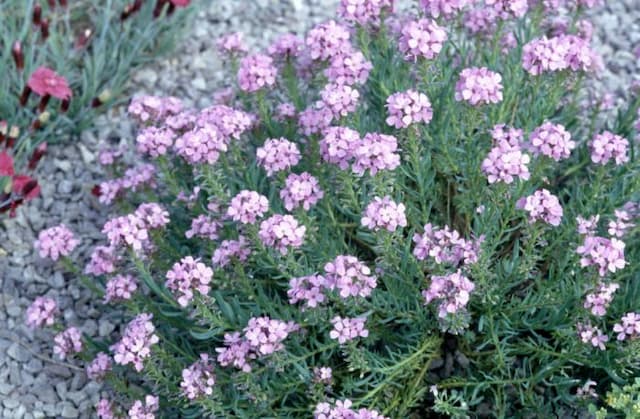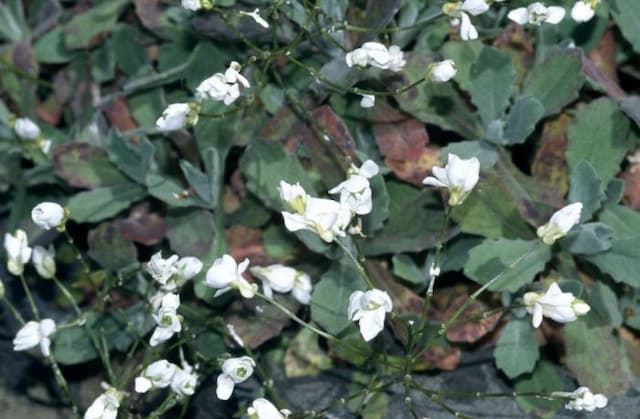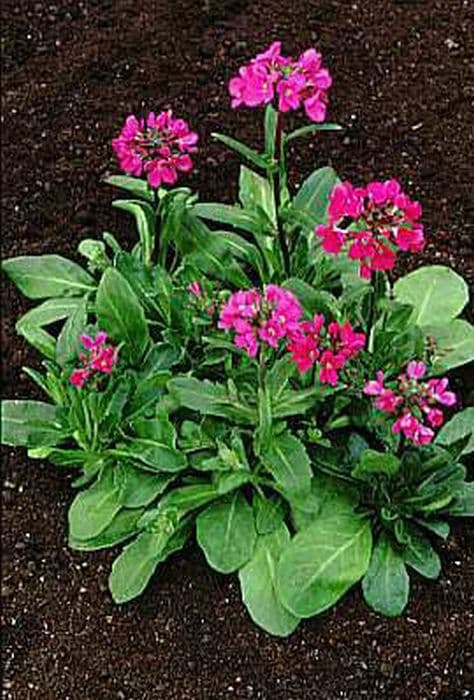Threeleaf Cuckooflower Cardamine trifolia

ABOUT
Cardamine trifolia, commonly known as three-leaf bittercress, is a perennial plant that is known for its lush, evergreen and ground-hugging nature. The leaves are typically arranged in whorls of three, which is a distinctive feature from which its name is derived. Each leaf is glossy and dark green, contributing to a rich tapestry of foliage that is quite attractive throughout the year. The three-leaf bittercress produces small, delicate white flowers that emerge above the leaves on slender stalks during its blooming season. These flowers are usually arranged in loose clusters and can add a subtle charm to the plant's overall appearance. The contrast between the dark green leaves and the white flowers can be visually striking in a shaded garden setting. The plant spreads by underground stems to form a low carpet, which can be dense and provide an excellent ground cover, filling the spaces between other plants effortlessly. This carpet-forming nature also means that it can cover the ground uniformly, creating a smooth, uninterrupted layer of greenery. Overall, the three-leaf bittercress has a simple but refined aesthetic that can fit well into woodland gardens, shade gardens, or as a filler in shaded borders due to its shade tolerance and these aesthetic characteristics. Its hardiness and evergreen leaves make it a valuable plant for providing year-round interest in suitable climates and locations.
About this plant
 Names
NamesFamily
Brassicaceae
Synonyms
Three-Leaf Cuckooflower, Three-Leaved Bittercress
Common names
Dentaria trifolia, Cardamine amara.
 Toxicity
ToxicityTo humans
Cardamine trifolia, commonly known as Threeleaf Cardamine, is not widely recognized as a toxic plant to humans. There is limited information available regarding its toxicity, and it does not appear on major lists of poisonous plants. However, as with any plant, individual allergies or sensitivities could potentially cause adverse reactions in some people. If any part of the plant were to be ingested and symptoms develop, it is advisable to seek medical advice.
To pets
Similarly for pets, Threeleaf Cardamine is not commonly listed among plants that are toxic to animals. There's a lack of specific information regarding its potential toxicity to dogs, cats, or other pets. As with humans, pets may also have individual sensitivities, and if any part of the plant is ingested by a pet and an adverse reaction is observed, it is best to consult with a veterinarian.
 Characteristics
CharacteristicsLife cycle
Perennials
Foliage type
Evergreen
Color of leaves
Green
Flower color
White
Height
4-5 inches (10-12.5 cm)
Spread
12-18 inches (30-45 cm)
Plant type
Herb
Hardiness zones
5
Native area
Europe
Benefits
 General Benefits
General Benefits- Low Maintenance: Cardamine trifolia is known for being a low-maintenance plant, well-suited for gardeners who prefer plants that do not require frequent care.
- Ground Cover: It effectively covers the ground with its dense foliage, suppressing weeds and reducing the need for mulch.
- Shade Tolerant: This plant can thrive in shaded areas where other plants might not grow, making it ideal for forested gardens or shaded landscapes.
- Ornamental Foliage: It has attractive, evergreen leaves that provide visual interest in the garden year-round.
- Supports Wildlife: It offers shelter and possibly food resources for various insects and small wildlife, enhancing biodiversity.
- Drought Resistance: Once established, Cardamine trifolia can tolerate periods of drought, making it suitable for gardens in drier climates or for water-wise landscaping.
- Soil Adaptability: It can adapt to a range of soil types, provided the soil is well-draining, which makes it versatile for different garden settings.
- Seasonal Interest: Its white flowers bloom in spring, offering an added seasonal interest to gardens.
- Non-Invasive: Unlike some ground covers, Cardamine trifolia is non-invasive, making it a responsible choice for gardeners concerned about plants that spread uncontrollably.
 Medical Properties
Medical Properties- This plant is not used for medical purposes.
 Air-purifying Qualities
Air-purifying QualitiesThis plant is not specifically known for air purifying qualities.
 Other Uses
Other Uses- Cardamine trifolia, commonly known as Threeleaf Bittercress, can serve as a ground cover in shady garden areas due to its dense, low-growing foliage and tolerance of low light conditions.
- In garden design, Cardamine trifolia's delicate white flowers add aesthetic value, especially when planted under deciduous trees where they can be highlighted in springtime.
- This plant can be used in moist woodland gardens to create a naturalized look, blending with ferns and other understory species.
- The foliage of the Cardamine trifolia remains green throughout the season, providing a year-round interest in garden borders or as part of a green mosaic in a shade garden.
- Threeleaf Bittercress can be utilized to prevent soil erosion in shaded slopes due to its mat-forming habit.
- The plant is suitable for planting in containers for shaded patios or balconies where other plants might struggle to thrive.
- Cardamine trifolia can occasionally be used in floral arrangements for a touch of natural, woodland charm.
- In habitat gardens, Cardamine trifolia provides early spring nectar for pollinators such as bees when other food sources are scarce.
- The plant can serve as a living mulch, suppressing weed growth around taller shade-loving plants.
- Because of its adaptability to cool, shady environments, Cardamine trifolia can be used in transition zones between cultivated gardens and wilder shaded areas to create a gradient of vegetation.
Interesting Facts
 Feng Shui
Feng ShuiThe Cardamine trifolia is not used in Feng Shui practice.
 Zodiac Sign Compitability
Zodiac Sign CompitabilityThe Cardamine trifolia is not used in astrology practice.
 Plant Symbolism
Plant Symbolism- Purity: The white flowers of Cardamine trifolia often symbolize purity and innocence, reflecting its clean, bright appearance.
- Humility: Being a ground-covering plant, Cardamine trifolia (Threeleaf Cuckooflower) can represent humility due to its low-growing nature.
- Tranquility: With its soft, forest green leaves, the Threeleaf Cuckooflower can be indicative of calm and tranquility, often being found in serene woodland settings.
- Protection: In some traditions, ground-hugging plants like the Cardamine trifolia are thought to offer protection to the other plants and creatures of the forest floor.
 Water
WaterThe Cardamine trifolia, commonly known as Threeleaf Cardamine, prefers consistently moist soil without being waterlogged. Water this plant approximately once a week, providing enough water to keep the soil moist to a depth of about 2 inches. Depending on the environmental conditions, this typically means using about 16-24 ounces of water for a medium-sized pot. During the active growing season in spring and early summer, you might need to water slightly more often. Always check the topsoil before watering; if it's dry to the touch, it's time to water. Reduce watering in the winter months when the plant's growth slows down.
 Light
LightThreeleaf Cardamine thrives in partial to full shade conditions. The ideal spot for this plant is one that receives filtered sunlight or is shaded for a good part of the day. Avoid placing it in direct, harsh sunlight as that can cause leaf burn. East or north-facing gardens or areas that receive dappled sunlight underneath a tree canopy are perfect for these woodland perennials.
 Temperature
TemperatureThreeleaf Cardamine is hardy and can tolerate a range of temperatures but grows best in cooler conditions. The plant is suited to withstand minimum temperatures down to around 20°F and is comfortable up to about 75°F. The ideal temperature range for promoting vigorous growth is between 60°F and 70°F. It's important to protect the plant from extreme cold and heat to prevent damage to the foliage and root system.
 Pruning
PruningPruning the Threeleaf Cardamine is mostly done to remove any brown or yellow leaves and to maintain the desired shape and size of the plant. This can be done as needed throughout the growing season, with the best time for a more thorough pruning being in late winter or early spring before new growth starts. Regular pruning helps encourage bushier growth and a more aesthetically pleasing appearance.
 Cleaning
CleaningAs needed
 Soil
SoilThreeleaf Cardamine prefers humus-rich, well-draining soil with a neutral to slightly acidic pH of around 6.5 to 7. A mix containing leaf mold, garden compost, and a small amount of perlite will create an ideal growing environment.
 Repotting
RepottingThreeleaf Cardamine should be repotted every 2-3 years or when it outgrows its current pot. It has a shallow root system, so choose a wide, shallow pot.
 Humidity & Misting
Humidity & MistingThreeleaf Cardamine thrives in moderate to high humidity levels, ideally around 60-70%. Avoid placing it in dry environments as it prefers consistent moisture in the air.
 Suitable locations
Suitable locationsIndoor
Place in bright, indirect light with high humidity.
Outdoor
Plant in dappled shade, ensure soil is moist and rich.
Hardiness zone
4-9 USDA
 Life cycle
Life cycleCardamine trifolia, commonly known as Threeleaf Bittercress, begins its life cycle as a seed lying dormant in the soil through winter. In spring, the seed germinates and a small seedling emerges, which then develops into a vegetative plant with a basal rosette of trifoliate leaves. After the vegetative growth, it enters the reproductive stage, producing small white flowers on erect stalks predominantly in the spring season. Following pollination, which is facilitated by insects, the plant forms fruit in the shape of elongated siliques containing multiple seeds. These seeds are eventually dispersed in the vicinity of the parent plant, often by wind, water, or animal action. The plant is perennial, which means after the seeds are dispersed, the vegetative plant remains and can enter another reproductive cycle in the following year.
 Propogation
PropogationPropogation time
Spring-Early Summer
Cardamine trifolia, commonly known as Three-Leaf Cardamine, is often propagated by division, which is the most popular method for this woodland perennial. The ideal time to propagate by division is in early spring or fall when the plant is not actively flowering. To propagate, carefully dig up the plant, ensuring as much of the root system is intact as possible. Gently divide the root clumps into smaller sections, each with several shoots and a good amount of roots. It is essential to replant the divisions immediately at the same depth they were growing before and water them thoroughly. Regular watering should continue until the new plants have established. This ensures that you have a higher chance of successful propagation, creating new plants that will mature and spread, maintaining the natural beauty and horticultural value of Three-Leaf Cardamine in the garden.






![Aubrieta [Axcent Burgundy]](/_next/image?url=https%3A%2F%2Fplants-admin.emdemapps.com%2Fimages%2Fplants%2F%2Fimages%2F604b5b7b548d8.png&w=640&q=75)


